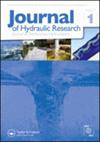Numerical modelling of levee breach with an improved slope-failure operator
IF 1.7
3区 工程技术
Q3 ENGINEERING, CIVIL
引用次数: 1
Abstract
A new slope-failure operator for bank sediment collapsing is proposed and tested. As compared to traditional operators that mainly depend on geometric parameters, the new operator considers the fact that collapsed sediments should firstly enter into the nearby water flow, and whether the collapsed sediments become part of the nearby bed should depend on the local flow and sediment conditions. Both the improved and traditional operators are implemented into the hydro-sediment-morphodynamic modelling framework. The model with these operators is applied to simulate experimental levee-breaching processes induced by overtopping flows. The model with the improved operator can produce numerical solutions (e.g. breaching shape, discharge) of much better accuracy (e.g. the RMSE for breaching discharge is 0.0024–0.0058 m³ s−1), as compared to the using of the traditional operator (e.g. the RMSE for breaching discharge is 0.0033–0.0087 m³ s−1).用改进的边坡破坏算子对堤防决口进行数值模拟
提出并测试了一种新的塌岸边坡破坏算子。与主要依赖几何参数的传统算子相比,新算子考虑了坍塌沉积物应首先进入附近水流的事实,并且坍塌沉积物是否成为附近河床的一部分应取决于当地的水流和沉积物条件。改进的和传统的算子都被应用到水沙形态动力学建模框架中。利用这些算子建立的模型模拟了漫顶流引起的溃堤过程。具有改进算子的模型可以产生精度高得多的数值解(例如,破裂形状、流量)(例如,爆裂流量的RMSE为0.0024–0.0058 m³ s−1),与使用传统操作员相比(例如,违规排放的RMSE为0.0033–0.0087 m³ s−1)。
本文章由计算机程序翻译,如有差异,请以英文原文为准。
求助全文
约1分钟内获得全文
求助全文
来源期刊

Journal of Hydraulic Research
工程技术-工程:土木
CiteScore
4.90
自引率
4.30%
发文量
55
审稿时长
6.6 months
期刊介绍:
The Journal of Hydraulic Research (JHR) is the flagship journal of the International Association for Hydro-Environment Engineering and Research (IAHR). It publishes research papers in theoretical, experimental and computational hydraulics and fluid mechanics, particularly relating to rivers, lakes, estuaries, coasts, constructed waterways, and some internal flows such as pipe flows. To reflect current tendencies in water research, outcomes of interdisciplinary hydro-environment studies with a strong fluid mechanical component are especially invited. Although the preference is given to the fundamental issues, the papers focusing on important unconventional or emerging applications of broad interest are also welcome.
 求助内容:
求助内容: 应助结果提醒方式:
应助结果提醒方式:


